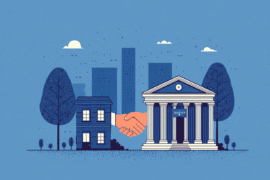This article may contain references to products or services from one or more of our advertisers or partners. We may receive compensation when you click on links to those products or services. Nonetheless, our opinions are our own.
The information presented in this article is accurate to the best of our knowledge at the time of publication. However, information is subject to change, and no guarantees are made about the continued accuracy or completeness of this content after its publication date.
- Getting to Know Lines of Credit and Credit Cards
- Considering Your Money Needs: When to Pick Each Choice
- Interest Rates and Fees: What You Should Know
- Flexibility and Control: How Each Choice Fits Your Spending Habits
- Building Credit: How Your Choice Affects Your Credit Score
- Tips for Caring for Your Money with Credit Lines and Cards
- Frequently Asked Questions
- Recommended Reads
Getting to Know Lines of Credit and Credit Cards
When managing your money, choosing between a line of credit and a credit card can be confusing. Both options offer flexibility and easy access to cash. However, it’s essential to understand the features of each to make a wise decision. A line of credit works like a reusable loan—you can borrow money up to a set limit when needed. You’ll only pay interest on the amount you use. This makes it a good choice for more considerable expenses, such as home improvements or unexpected medical bills.
On the other hand, a credit card usually comes with a fixed limit and allows you to buy goods and services immediately. Credit cards often include rewards, cashback, or points for everyday purchases.
Here are some key differences to consider:
- Accessibility: Lines of credit are better suited for larger purchases, while credit cards work well for everyday spending.
- Interest Rates: Lines of credit typically have lower interest rates than credit cards, especially if you have a good credit score.
- Payment Flexibility: Credit cards require at least a minimum monthly payment, while lines of credit often offer more flexible repayment options.
| Feature | Line of Credit | Credit Card |
|---|---|---|
| Interest Rates | Usually lower | Typically higher |
| Purpose | Large expenses | Everyday spending |
| Rewards | Limited | Often includes rewards |
Ultimately, the right choice depends on how you manage money and how you plan to use credit. Take time to think through your needs to choose the option that best fits your financial goals.
Considering Your Money Needs: When to Pick Each Choice
When choosing between a line of credit and a credit card, your financial needs will help determine the right option. A line of credit might be best if you face enormous, unexpected costs like home repairs or medical expenses. It allows you to borrow more and usually offers lower interest rates.
A credit card is often better for managing daily purchases or as a backup for minor emergencies. It provides convenience along with rewards programs.
To help compare your options, consider the following:
- Borrowing Limits: Lines of credit usually offer higher limits than credit cards.
- Interest Rates: Lines of credit typically have lower rates. Credit cards may have higher rates, but they also offer rewards.
- Repayment Flexibility: Credit cards require minimum monthly payments. Lines of credit may allow more flexible repayment terms.
| Feature | Line of Credit | Credit Card |
|---|---|---|
| Typical Interest Rate | Variable, often lower | Fixed, usually higher |
| Access to Funds | Withdraw as needed | Direct purchases |
| Rewards | No | Yes |
Reviewing your financial situation allows you to choose the option that best suits your needs and goals, helping you move toward a more stable economic future.
Interest Rates and Fees: What You Should Know
When comparing a line of credit and a credit card, it’s essential to understand how interest rates and fees work. These details can have a significant impact on your financial choices. A line of credit usually has a lower interest rate than a standard credit card, making it better for large, unexpected costs or long-term borrowing. However, rates can vary based on your credit score, so comparing offers and understanding the terms is essential before deciding.
You should also consider the associated fees:
- Annual Fees: Some credit cards charge annual fees, while many lines of credit do not.
- Transaction Fees: Credit cards may charge fees for cash advances; lines of credit typically do not.
- Maintenance Fees: Lines of credit may charge monthly fees, mainly if unused.
| Feature | Line of Credit | Credit Card |
|---|---|---|
| Interest Rate | Generally lower | Higher, varies by card |
| Annual Fees | Rare | Common |
| Cash Advance Fees | No | Yes |
Understanding these cost-related factors will help you make an informed choice that aligns with your financial goals. Don’t rush—each detail can affect your overall financial health.
Voted "Best Overall Budgeting App" by Forbes and WSJ
Monarch Money helps you budget, track spending, set goals, and plan your financial future—all in one app.
Get 50% OFF your first year with code MONARCHVIP
Flexibility and Control: How Each Choice Fits Your Spending Habits
When considering whether a line of credit or a credit card fits your spending habits, it’s important to compare features that match your financial lifestyle. A line of credit lets you borrow only what you need, leading to lower interest costs if managed wisely. It’s beneficial for people with recurring expenses who want to avoid paying everything upfront—like home repairs or medical bills.
Key advantages of a line of credit:
- You can borrow varying amounts as your needs change.
- You pay interest only on the funds you use.
- Higher credit limits may be available based on your creditworthiness.
A credit card provides a simple way to make purchases and often comes with rewards or cashback. If you frequently make smaller purchases, a credit card can help you stay within budget while earning perks.
Main features of credit cards:
- Manageable expense tracking via monthly statements.
- Grace periods on interest if you pay your balance in full.
- Bonus rewards for specific categories based on spending patterns.
The key to using either option effectively is to stay disciplined with your spending, make the most of available benefits, and stay within your budget.
Building Credit: How Your Choice Affects Your Credit Score
Your choice between a line of credit and a credit card can influence your credit score differently. Each option comes with factors that can either help or hurt your credit.
Credit cards usually have higher interest rates but offer a reliable way to build credit through regular use and on-time payments. Keeping your credit utilization below 30% of your limit can significantly improve your score.
Lines of credit function more like loans with revolving balances. They often have lower interest rates and flexible repayment options. This can be beneficial if you want quick access to funds in emergencies. However, consistently withdrawing the entire amount may increase your debt-to-income ratio, which can lower your score.
Key credit-impacting factors:
- Flexibility: Lines of credit usually offer more borrowing options.
- Interest Rates: Credit cards often have higher rates than lines of credit.
- Utilization: How you use your credit can significantly impact your score.
- Payment History: On-time payments are essential for maintaining a strong score.
| Feature | Credit Card | Line of Credit |
|---|---|---|
| Interest Rate | Generally higher | Usually lower |
| Flexibility | Limited to transactions | More versatile |
| Monthly Payments | Variable based on usage | Predictable interest |
Tips for Caring for Your Money with Credit Lines and Cards
Managing your money with credit lines and credit cards takes planning. Here are smart tips to help you stay financially healthy:
- Know Your Limits: To maintain or improve your credit score, stay aware of your credit limit and keep usage under 30%.
- Prioritize Payments: Pay off high-interest debts first to reduce long-term costs.
- Set Alerts: Use reminders to avoid missed payments and late fees.
- Create a Budget: Allocate a specific amount for credit card payments and avoid overspending.
| Feature | Line of Credit | Credit Card |
|---|---|---|
| Interest Rates | Generally lower | Higher, varies by card |
| Flexibility | More flexible in usage | Limited to purchases |
| Rewards | Usually none | Offers rewards and cashback |
By understanding how these options fit into your budget and goals, you can make smart decisions that strengthen your overall financial health.
Pros and Cons of Using Lines of Credit
Lines of credit usually have lower interest rates than credit cards, making them cost-effective for borrowing. They also provide flexibility in using funds for various needs. However, they typically don’t offer rewards like credit cards do. You also need to manage them carefully to avoid overspending. Lines of credit can be an affordable and flexible financial tool that can be used wisely.
Personal Line of Credit Pros and Cons
A personal line of credit can help in emergencies, offering quick access to funds at lower rates than credit cards. You borrow only what you need, making it flexible. However, poor planning can lead to excessive borrowing. Used responsibly, a personal line of credit helps handle short-term money needs.
Pros and Cons of Using Credit Cards
Credit cards are convenient and secure for purchases. They offer rewards like cashback or travel points and help build credit when used wisely. However, high interest rates can make them expensive if you don’t pay off your balance. Overspending can also lead to debt. With disciplined use, credit cards offer valuable benefits but require budgeting and prompt payments.
Credit Card Pros and Cons
Credit cards are a standard financial tool offering convenience, rewards, and a way to build credit. They provide safety during purchases and can earn cashback or travel perks. However, their high interest rates make them costly if not used carefully. Paying off the full balance monthly is key to avoiding debt. Used responsibly, credit cards are valuable tools, but they must be managed with care.
Frequently Asked Questions
What is a line of credit?
A line of credit is a flexible loan from a financial institution. It allows you to borrow up to a set limit and only pay interest on the amount used. It helps manage cash flow or unexpected expenses.
What is a credit card?
A credit card is a payment tool that lets you borrow funds up to a limit for purchases. You must repay the amount borrowed with interest, usually monthly. Credit cards often include rewards, cashback, and purchase protection.
What are the main differences between a line of credit and a credit card?
Lines of credit offer flexible access to funds with varied repayment options. Credit cards are for everyday purchases with fixed monthly payments. Interest rates also vary, but lines of credit typically have lower rates.
When should I consider a line of credit?
Use a line of credit if you need funds for substantial expenses or projects or if you have irregular income. It offers flexibility and lower interest than many credit cards.
When is a credit card a better option?
Credit cards are ideal for frequent purchases, especially if you can pay off the balance monthly. They offer convenience, rewards, and fraud protection.

Reviewed and edited by Albert Fang.
See a typo or want to suggest an edit/revision to the content? Use the contact us form to provide feedback.
At FangWallet, we value editorial integrity and open collaboration in curating quality content for readers to enjoy. Much appreciated for the assist.
Did you like our article and find it insightful? We encourage sharing the article link with family and friends to benefit as well - better yet, sharing on social media. Thank you for the support! 🍉
Article Title: Smart Borrowing: When to Use a Line of Credit Instead of a Credit Card
https://fangwallet.com/2025/03/31/line-of-credit-instead-of-a-credit-card/The FangWallet Promise
FangWallet is an editorially independent resource - founded on breaking down challenging financial concepts for anyone to understand since 2014. While we adhere to editorial integrity, note that this post may contain references to products from our partners.
The FangWallet promise is always to have your best interest in mind and be transparent and honest about the financial picture.
Become an Insider

Subscribe to get a free daily budget planner printable to help get your money on track!
Make passive money the right way. No spam.
Editorial Disclaimer: The editorial content on this page is not provided by any of the companies mentioned. The opinions expressed here are the author's alone.
The content of this website is for informational purposes only and does not represent investment advice, or an offer or solicitation to buy or sell any security, investment, or product. Investors are encouraged to do their own due diligence, and, if necessary, consult professional advising before making any investment decisions. Investing involves a high degree of risk, and financial losses may occur including the potential loss of principal.
Source Citation References:
+ Inspo
There are no additional citations or references to note for this article at this time.












































